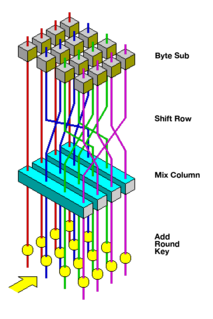Related Research Articles

The Advanced Encryption Standard (AES), also known by its original name Rijndael, is a specification for the encryption of electronic data established by the U.S. National Institute of Standards and Technology (NIST) in 2001.
In cryptography, a block cipher is a deterministic algorithm operating on fixed-length groups of bits, called blocks. They are specified elementary components in the design of many cryptographic protocols and are widely used to the encryption of large amounts of data, including data exchange protocols. It uses blocks as an unvarying transformation.

In cryptography, RC6 is a symmetric key block cipher derived from RC5. It was designed by Ron Rivest, Matt Robshaw, Ray Sidney, and Yiqun Lisa Yin to meet the requirements of the Advanced Encryption Standard (AES) competition. The algorithm was one of the five finalists, and also was submitted to the NESSIE and CRYPTREC projects. It was a proprietary algorithm, patented by RSA Security.

In cryptography, CAST-128 is a symmetric-key block cipher used in a number of products, notably as the default cipher in some versions of GPG and PGP. It has also been approved for Government of Canada use by the Communications Security Establishment. The algorithm was created in 1996 by Carlisle Adams and Stafford Tavares using the CAST design procedure.
In cryptography, a Feistel cipher is a symmetric structure used in the construction of block ciphers, named after the German-born physicist and cryptographer Horst Feistel, who did pioneering research while working for IBM (USA); it is also commonly known as a Feistel network. A large proportion of block ciphers use the scheme, including the US Data Encryption Standard, the Soviet/Russian GOST and the more recent Blowfish and Twofish ciphers. In a Feistel cipher, encryption and decryption are very similar operations, and both consist of iteratively running a function called a "round function" a fixed number of times.
In cryptography, Lucifer was the name given to several of the earliest civilian block ciphers, developed by Horst Feistel and his colleagues at IBM. Lucifer was a direct precursor to the Data Encryption Standard. One version, alternatively named DTD-1, saw commercial use in the 1970s for electronic banking.
In cryptography, Camellia is a symmetric key block cipher with a block size of 128 bits and key sizes of 128, 192 and 256 bits. It was jointly developed by Mitsubishi Electric and NTT of Japan. The cipher has been approved for use by the ISO/IEC, the European Union's NESSIE project and the Japanese CRYPTREC project. The cipher has security levels and processing abilities comparable to the Advanced Encryption Standard.
MARS is a block cipher that was IBM's submission to the Advanced Encryption Standard process. MARS was selected as an AES finalist in August 1999, after the AES2 conference in March 1999, where it was voted as the fifth and last finalist algorithm.
CRYPTREC is the Cryptography Research and Evaluation Committees set up by the Japanese Government to evaluate and recommend cryptographic techniques for government and industrial use. It is comparable in many respects to the European Union's NESSIE project and to the Advanced Encryption Standard process run by National Institute of Standards and Technology in the U.S.

In cryptography, LOKI97 is a block cipher which was a candidate in the Advanced Encryption Standard competition. It is a member of the LOKI family of ciphers, with earlier instances being LOKI89 and LOKI91. LOKI97 was designed by Lawrie Brown, assisted by Jennifer Seberry and Josef Pieprzyk.
In cryptography, MISTY1 is a block cipher designed in 1995 by Mitsuru Matsui and others for Mitsubishi Electric.

In cryptography, DEAL is a symmetric block cipher derived from the Data Encryption Standard (DES). The design was proposed in a report by Lars Knudsen in 1998, and was submitted to the AES contest by Richard Outerbridge.
In cryptography, Mercy is a tweakable block cipher designed by Paul Crowley for disk encryption.
In cryptography, SC2000 is a block cipher invented by a research group at Fujitsu Labs. It was submitted to the NESSIE project, but was not selected. It was among the cryptographic techniques recommended for Japanese government use by CRYPTREC in 2003, however, has been dropped to "candidate" by CRYPTREC revision in 2013.
In cryptography, DFC is a symmetric block cipher which was created in 1998 by a group of researchers from École Normale Supérieure, CNRS, and France Télécom and submitted to the AES competition.
In cryptography, Hierocrypt-L1 and Hierocrypt-3 are block ciphers created by Toshiba in 2000. They were submitted to the NESSIE project, but were not selected. Both algorithms were among the cryptographic techniques recommended for Japanese government use by CRYPTREC in 2003, however, both have been dropped to "candidate" by CRYPTREC revision in 2013.
In cryptography, E2 is a symmetric block cipher which was created in 1998 by NTT and submitted to the AES competition.
In cryptography, CIPHERUNICORN-E is a block cipher created by NEC in 1998. It was among the cryptographic techniques recommended for Japanese government use by CRYPTREC in 2003. However, it has been dropped to "candidate" level by the CRYPTREC revision of 2013.
In cryptography, COCONUT98 is a block cipher designed by Serge Vaudenay in 1998. It was one of the first concrete applications of Vaudenay's decorrelation theory, designed to be provably secure against differential cryptanalysis, linear cryptanalysis, and even certain types of undiscovered cryptanalytic attacks.
The following outline is provided as an overview of and topical guide to cryptography:
References
- Matt Robshaw (14 December 2001). "A Cryptographic Review of CIPHERUNICORN-A" (PDF). Retrieved 21 January 2007.